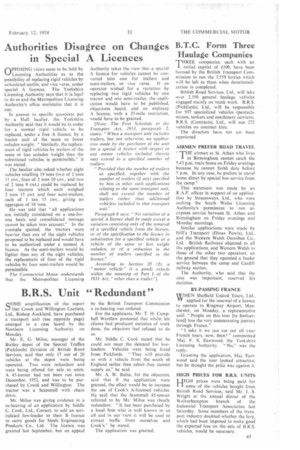O PPOSING views seem to be held by Licensing Authorities as
Page 37

If you've noticed an error in this article please click here to report it so we can fix it.
to the possibility of replacing rigid vehicles by articulated outfits, and vice versa, under special A licences. The Yorkshire Licensing Authority says that it is legal to do so and the Metropolitan Licensing Authority's office maintains that it is not.
In answer to specific questions put by a Hull haulier, the Yorkshire Authority said that it would be in order for a normal rigid vehicle to be replaced, under a free A licence, by a tractor unit of the same or lower unladen weight. "Similarly, the replacement of rigid vehicles by trailers of the same or less unladen weight than the substituted vehicles is permissible," it was stated.
The haulier also asked whether eight vehicles totalling 19 tons (two of 2 tons 11 cwt., four of 2 tons 10 cwt., and two of 2 tons 9 cwt.) could be replaced by four tractors which each weighed 2 tons 15 cwt. and four semi-trailers, each of 1 ton 15 cwt., giving an aggregate of 18 tons.
He was told that "nil applications are initially considered on a one-forone basis and consolidated tonnage cannot be taken into account." In the example quoted, the tractors were heavier, than any of the eight vehicles proposed to be replaced and would have to be authorized under a normal A licence. As the semi-trailers would be lighter than any of the eight vehicles, the replacement of four of the rigid vehicles by four semi-trailers would be permissible.
The Commercial Motor understands that the Metropolitan Licensing
Authority 'takes the view that a special A licence for vehicles cannot be converted into one for trailers and semi-trailers, or vice versa, If an operator wished for a variation by replacing two rigid vehicles by one tractor and one semi-trailer, the application would have to be published, objections heard, and an ordinary A licence, with a 25-mile restriction, would have to be granted.
[Note: The First Schedule to the Transport Act, 1953, paragraph 2, states; " When a transport unit includes trailers, but not otherwise, an application made by the purchaser of the unit for a special A licence with respect to any motor vehicles included therein may extend to a specified number of trailers: "Provided that the number of trailers so specified, together with the number of trailers (if any) specified by hint in other such applications 'dating to the same transport unit, shall not exceed the number of trailers (other than additional vehicles) included in that transport Unit."
Paragraph 6 says: "No variation of a special A licence shall be made except a variation consisting only ol the removal of a specified vehicle from the licence, or of the specification in the licence in substitution for a specified vehicle of a vehicle of the same or less weight unladen, or of a reduction in the number of trailers specified in the licence."
According to Section 35 (2). a " motor vehicle" is a goods vehicle within the meaning of Part 1 of the 1933 Act, " other than a trailer."]




































































































